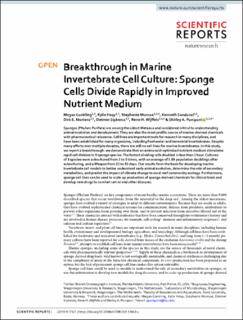| dc.contributor.author | Conkling, Megan | |
| dc.contributor.author | Hesp, Kylie | |
| dc.contributor.author | Munroe, Stephanie | |
| dc.contributor.author | Sandoval, Kenneth | |
| dc.contributor.author | Martens, Dirk E. | |
| dc.contributor.author | Sipkema, Detmer | |
| dc.contributor.author | Wijffels, Rene Hubertus | |
| dc.contributor.author | Pomponi, Shirley A. | |
| dc.date.accessioned | 2020-06-08T09:19:07Z | |
| dc.date.available | 2020-06-08T09:19:07Z | |
| dc.date.created | 2020-01-16T17:11:17Z | |
| dc.date.issued | 2019 | |
| dc.identifier.citation | Conkling, M., Hesp, K., Munroe, S., Sandoval, K., Martens, D. E., Sipkema, D., Wijffels, R. H. & Pomponi, S. A. (2019). Breakthrough in marine invertebrate cell culture: Sponge cells divide rapidly in improved nutrient medium. Scientific Reports, 9: 17321. doi: | en_US |
| dc.identifier.issn | 2045-2322 | |
| dc.identifier.uri | https://hdl.handle.net/11250/2657145 | |
| dc.description.abstract | Sponges (Phylum Porifera) are among the oldest Metazoa and considered critical to understanding animal evolution and development. They are also the most prolific source of marine-derived chemicals with pharmaceutical relevance. Cell lines are important tools for research in many disciplines, and have been established for many organisms, including freshwater and terrestrial invertebrates. Despite many efforts over multiple decades, there are still no cell lines for marine invertebrates. In this study, we report a breakthrough: we demonstrate that an amino acid-optimized nutrient medium stimulates rapid cell division in 9 sponge species. The fastest dividing cells doubled in less than 1 hour. Cultures of 3 species were subcultured from 3 to 5 times, with an average of 5.99 population doublings after subculturing, and a lifespan from 21 to 35 days. Our results form the basis for developing marine invertebrate cell models to better understand early animal evolution, determine the role of secondary metabolites, and predict the impact of climate change to coral reef community ecology. Furthermore, sponge cell lines can be used to scale-up production of sponge-derived chemicals for clinical trials and develop new drugs to combat cancer and other diseases. | en_US |
| dc.language.iso | eng | en_US |
| dc.publisher | Springer Nature | en_US |
| dc.rights | Navngivelse 4.0 Internasjonal | * |
| dc.rights.uri | http://creativecommons.org/licenses/by/4.0/deed.no | * |
| dc.title | Breakthrough in marine invertebrate cell culture : Sponge cells divide rapidly in improved nutrient medium | en_US |
| dc.type | Peer reviewed | en_US |
| dc.type | Journal article | en_US |
| dc.description.version | publishedVersion | en_US |
| dc.rights.holder | © 2019 The Author(s) | |
| dc.subject.nsi | VDP::Landbruks- og Fiskerifag: 900::Fiskerifag: 920 | |
| dc.subject.nsi | VDP::Matematikk og Naturvitenskap: 400::Basale biofag: 470::Genetikk og genomikk: 474 | |
| dc.source.pagenumber | 10 | en_US |
| dc.source.volume | 9 | en_US |
| dc.source.journal | Scientific Reports | en_US |
| dc.source.issue | 1 | en_US |
| dc.identifier.doi | 10.1038/s41598-019-53643-y | |
| dc.identifier.cristin | 1775244 | |
| dc.relation.project | EC/H2020/679848 | en_US |
| dc.relation.project | EU/ITN-2013-BluePharmTrain-607786 | en_US |

